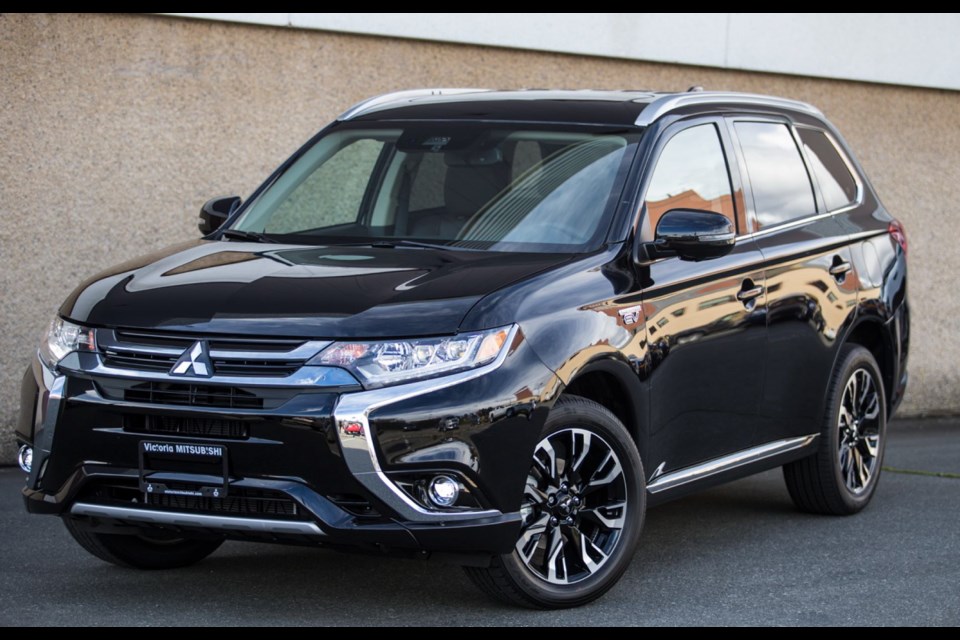Mitsubishi is tapping into the unabated popularity of SUVs and the growing interest in vehicle electrification with the 2018 Outlander PHEV.
With gas hitting $1.50 a litre, consumers are looking at any alternative to avoid — or at least slow down — the pain at the pump.
For the past few decades, gasoline-electric hybrids have been the answer for many. Others willing to go further have gone fully electric, but with a reduced range as the major hurdle.
Mitsubishi is betting consumers who like to have their cake and eat it too will consider a plug-in hybrid electric vehicle instead.
The premise is simple. A PHEV typically operates on electric-vehicle mode, powered by a small onboard battery, until the battery is exhausted. It then continues the journey as a regular gasoline-electric vehicle until the battery is recharged.
As just a PHEV, the Outlander is not unique. Competitors using the same technology include the Mini Cooper Countryman, Kia Optima, a number of BMW models, the Audi Sportback e-tron, Ford CMAX Energi, Chrysler Pacifica Hybrid, Hyundai Sonata PHEV, Honda Clarity, Mercedes-Benz GLC 350e, Toyota Prius Prime and the Volvo XC60 and XC90.
What makes the Outlander unique is how it uses multiple technologies in one vehicle.
We start off with the fact the Outlander PHEV has two electric motors, one in the front and one in back. By pressing a 4WD LOCK button, it simulates the locking of a centre differential in a conventional four-wheel-drive vehicle. This makes the Outlander the most capable off-road vehicle in the bunch.
It has three drive modes: EV, using electric power only; Series hybrid mode, where the gas engine generates electricity when the battery is low or additional power is required (for overtaking); and Parallel hybrid mode, where both gas and electric engines work in tandem.
By switching seamlessly between modes, the Outlander can conserve when possible, and assist when necessary, depending on driving conditions and battery charge levels.
The Outlander has steering wheel mounted paddles that increase or decreasing the amount of regenerative braking (from B0 to B5). At its highest setting you can feel a drag as soon as you take your foot off the accelerator. It becomes an interesting exercise to calculate the amount of regenerative braking (instead of the actual brakes) to use when approaching a traffic light on the highway.
The driver can also choose between two battery modes: Battery Save and Battery Charge. On the former, the driver can opt to save what charge that is left in the battery for later use — for use in the city only, for example. On the latter, you can instruct the car to increase battery charging while on the road, so that you have sufficient juice at a later date.
The Outlander’s lithium-ion battery size, at 12 kWh, is notable as the third largest in this field. This gives the vehicle a useful range of around 35 kilometres before the gasoline engine comes into play.
When it comes time for charging, the Outlander charges (pun intended) to the head of the pack as the only vehicle in the field to offer a Level 3 DC fast charger. This enables the Outlander to pick up an 80 per cent charge in about 25 minutes.
Using the more common 240V Level 2 charger (also included), the battery can be charged in roughly three-and-a-half hours. Using a regular 120V household outlet, a full charge takes about eight hours.
Overall, the Outlander is rated at 3.0 litres per 100 km in the city and 3.4 on the highway.
Despite all this technology bursting from the seams, the Outlander PHEV is priced starting from $42,998 (less a $2,500 incentive from the province of sa���ʴ�ý)
The PHEV comes in three trims. My tester was the top-of-the-line GT version, with a suite of active safety features, including forward collision mitigation with pedestrian detection. It also included a 360-degree camera (with a camera pointed at the front wheel to assist in off-road or parking situations) and a 710-watt Rockford Fosgate audio system.
As fitting for a electric-drive vehicle, the instrument panel offers a rich array of energy usage information, including an energy-use monitor, energy flow and other eco information. It has a handy countdown gauge to let you know the expected range for the battery and gasoline.
When you switch off the vehicle, it also rates your driving, with green leaves indicating the eco-friendiness of your driving.
The Outlander PHEV is a good indication of where the auto industry as a whole is heading. With gas prices at all-time highs, the only way to avoid, or just to reduce, the impact is to turn to electricity. With the Outlander, people can get the benefits of the emerging technology while reaping the attributes that make SUVs so popular these days.
The spec sheet
Type: Compact SUV, front gasoline engine, front and rear electric motors, all-wheel-drive
Engine type: Plug-in Hybrid Electric Vehicle
Engine (gas): 2.0-litre four-cylinder, 117 hp at 4,500 r.p.m., 137 lb.-ft. of torque at 4,500 r.p.m.
Engine electric: AC synchronous permanent magnetic
Engine (electric): 80 hp and 101 lb.-ft. of torque
Engine (rear): 80 hp and 144 lb.-ft. of torque
Battery: Lithium-ion, 12kWh/ 300V
Charging time (CHAdeMO): 25 minutes to 80 per cent
Charging time (240/120V): 3.5 hours/ 8 hours @ 12A
Transmission: Single speed automatic
Transaxle front: Drive mode switchable reduction gear box
Transaxle rear: Fixed reduction gear box
EV battery range: 35 km
kWh per 100 km: 27.7
Total range (gas and electric): 499 km
Dimensions (mm): Length, 184.8; width, 1,800; height, 1,710; wheelbase, 2,670
Curb weight (kg): 1,895
Price (base/as tested): $49,998/ $49,298 (includes $1,700 freight and PDI and $100 AC tax, less $2,500 sa���ʴ�ý clean vehicle incentive)
Options: Nil
Tires: 225/55 R18 on alloy wheels
Fuel type: Regular
Fuel economy (Le/100km): 3.0 city/ 3.4 highway
Warranty: Five years/100,000 km new car, 10 years/160,000 km powertrain and main drive battery, five years/ unlimited km roadside assistance



